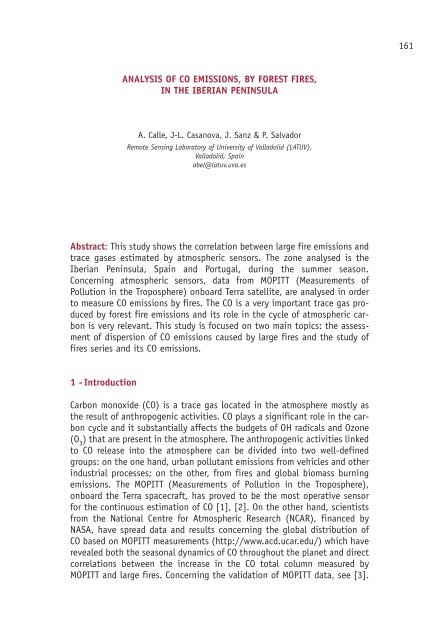7th Workshop on Forest Fire Management - EARSeL, European ...
7th Workshop on Forest Fire Management - EARSeL, European ...
7th Workshop on Forest Fire Management - EARSeL, European ...
Create successful ePaper yourself
Turn your PDF publications into a flip-book with our unique Google optimized e-Paper software.
Abstract: This study shows the correlati<strong>on</strong> between large fire emissi<strong>on</strong>s and<br />
trace gases estimated by atmospheric sensors. The z<strong>on</strong>e analysed is the<br />
Iberian Peninsula, Spain and Portugal, during the summer seas<strong>on</strong>.<br />
C<strong>on</strong>cerning atmospheric sensors, data from MOPITT (Measurements of<br />
Polluti<strong>on</strong> in the Troposphere) <strong>on</strong>board Terra satellite, are analysed in order<br />
to measure CO emissi<strong>on</strong>s by fires. The CO is a very important trace gas produced<br />
by forest fire emissi<strong>on</strong>s and its role in the cycle of atmospheric carb<strong>on</strong><br />
is very relevant. This study is focused <strong>on</strong> two main topics: the assessment<br />
of dispersi<strong>on</strong> of CO emissi<strong>on</strong>s caused by large fires and the study of<br />
fires series and its CO emissi<strong>on</strong>s.<br />
1 - Introducti<strong>on</strong><br />
ANALYSIS OF CO EMISSIONS, BY FOREST FIRES,<br />
IN THE IBERIAN PENINSULA<br />
A. Calle, J-L. Casanova, J. Sanz & P. Salvador<br />
Remote Sensing Laboratory of University of Valladolid (LATUV),<br />
Valladolid, Spain<br />
abel@latuv.uva.es<br />
Carb<strong>on</strong> m<strong>on</strong>oxide (CO) is a trace gas located in the atmosphere mostly as<br />
the result of anthropogenic activities. CO plays a significant role in the carb<strong>on</strong><br />
cycle and it substantially affects the budgets of OH radicals and Oz<strong>on</strong>e<br />
(O 3 ) that are present in the atmosphere. The anthropogenic activities linked<br />
to CO release into the atmosphere can be divided into two well-defined<br />
groups: <strong>on</strong> the <strong>on</strong>e hand, urban pollutant emissi<strong>on</strong>s from vehicles and other<br />
industrial processes; <strong>on</strong> the other, from fires and global biomass burning<br />
emissi<strong>on</strong>s. The MOPITT (Measurements of Polluti<strong>on</strong> in the Troposphere),<br />
<strong>on</strong>board the Terra spacecraft, has proved to be the most operative sensor<br />
for the c<strong>on</strong>tinuous estimati<strong>on</strong> of CO [1], [2]. On the other hand, scientists<br />
from the Nati<strong>on</strong>al Centre for Atmospheric Research (NCAR), financed by<br />
NASA, have spread data and results c<strong>on</strong>cerning the global distributi<strong>on</strong> of<br />
CO based <strong>on</strong> MOPITT measurements (http://www.acd.ucar.edu/) which have<br />
revealed both the seas<strong>on</strong>al dynamics of CO throughout the planet and direct<br />
correlati<strong>on</strong>s between the increase in the CO total column measured by<br />
MOPITT and large fires. C<strong>on</strong>cerning the validati<strong>on</strong> of MOPITT data, see [3].<br />
161
















